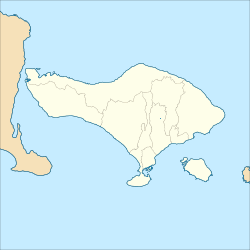| UTC time | 1917-01-20 23:11:34 |
|---|---|
| ISC event | 913396 |
| USGS-ANSS | ComCat |
| Local date | January 21, 1917 |
| Local time | 07:11 |
| Magnitude | 6.6 Ms [1] |
| Epicenter | 8°29′31″S115°11′53″E / 8.492°S 115.198°E [2] |
| Areas affected | Dutch East Indies, Bali |
| Max. intensity | MMI IX (Violent) |
| Tsunami | Minor |
| Landslides | Many |
| Foreshocks | Yes |
| Casualties | 1,500 |
The 1917 Bali earthquake occurred at 07:11 local time on 21 January (23:11 on 20 January UTC). It had an estimated magnitude of 6.6 on the surface-wave magnitude scale and had a maximum perceived intensity of IX (Violent) on the Mercalli intensity scale. It caused widespread damage across Bali, particularly in the south of the island. It triggered many landslides, which caused 80% of the 1,500 casualties.





